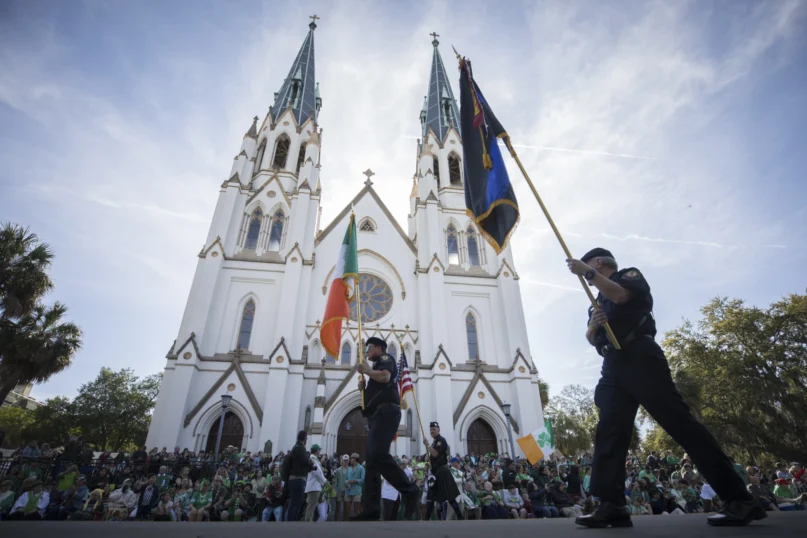SAVANNAH, Ga. (AP) — There was no green beer, no pickup trucks towing parade floats or throngs of tourists in gaudy green outfits. Instead, just a few dozen of Savannah’s early Irish immigrants marched a half-mile from a hotel near the riverfront to attend a special service at what then was the city’s only Roman Catholic church.
That modest procession on March 17, 1824, launched one of the most beloved — and profitable — traditions in Savannah. On Saturday, Georgia’s oldest city will celebrate the 200th anniversary of its St. Patrick’s Day parade, which has grown over time into one of America’s largest. Thousands of revelers are expected to cram sidewalks and squares along the parade route through Savannah’s downtown historic district.
More than 18,000 hotel rooms in Savannah and surrounding Chatham County are nearly sold out for the weekend. The parade lineup is bursting with at least 230 pipe-and-drum bands, chauffeur-driven dignitaries, marching military units and shamrock-decorated floats. Downtown bars have stocked up on extra kegs of beer, and the city has rented more than 320 portable toilets for those imbibing.
“We’re expecting historic crowds from visitors and residents alike,” said Savannah City Manager Jay Melder.
Over the past two centuries, St. Patrick’s Day in Savannah has morphed into perhaps the South’s biggest street party between Mardi Gras in New Orleans and Florida’s raucous spring break.
It’s a far cry from how Savannah’s celebration began.
Founded as a nondenominational charity to assist poor Irish immigrants, the Hibernian Society of Savannah had an important day planned on March 17, 1824. The group invited Bishop John England, an Irish native appointed to lead the newly formed Diocese of Charleston, South Carolina, to come to Savannah and speak at the city’s Roman Catholic church.
The Hibernians hosted England on St. Patrick’s Day during their morning meeting at the City Hotel near the bluff overlooking the Savannah River. Then they marched in procession, accompanied by a band and a flag-bearer whose banner was decorated with a symbolic Irish harp and shamrocks, to hear the bishop speak at noon at St. John the Baptist Church.
“May the example of Savannah be widely influential,” the bishop told an audience of both Catholics and Protestants inside the packed church while a crowd of onlookers stood outside in the rain, the Savannah Republican newspaper reported. “Here men who differ in religion may meet as friends and brethren.”
Afterward, the Irish society marched back to the hotel, where the bishop joined about 80 members for an evening banquet marked by a steady stream of toasts, said Howard Keeley, director of the Center for Irish Research and Teaching at Georgia Southern University.
“They partied the night away, apparently,” said Keeley, who studies the history of Irish immigrants in Georgia. “It was a big celebration. The Hibernians had always had these celebrations since their founding in 1812. This one was just kind of amped up by the presence of the bishop.”
Like even older St. Patrick’s Day parades in New York and Boston, Savannah’s parade is likely rooted in military units celebrating the holiday during the American Revolution, Keeley said. He noted there are accounts of Irish-born soldiers marching on St. Patrick’s Day while serving under George Washington.
Savannah’s celebration grew along with its Irish population. Laborers from Ireland settled in the Southern port city in the 1830s to help build railroads and canals. In the 1840s, the potato famine in Ireland drove as many as 2 million immigrants to U.S. shores, causing Savannah’s Irish-born population to double, Keeley said.
In the decades following the Civil War, Savannah’s holiday started showing glimmers of the more commercially driven celebrations to come.
Local clothing stores stocked green neckties and gloves by 1875, according to “The Days We’ve Celebrated,” a history of St. Patrick’s Day festivities in Savannah by the late William L. Fogarty, who served as the parade’s 1986 grand marshal.
And following the 1888 celebration, a newspaper reported that Savannah officials had ordered businesses to close for a day because “the city is agitated by Sunday cocktails.”
Even by the 1960s, Savannah’s parade had yet to become a full-blown tourism dynamo.
Tim Mahoney, chairman of the parade’s organizing committee, recalled that when his father held the same post in 1969, the parade got planned “on somebody’s dining room table” and was pulled together from high school bands, locally based military units and Savannah’s Irish families.
“They had no money; they had no resources,” Mahoney said. “But in true Irish leadership fashion they just rolled up their sleeves and said, `Heck, we’re going to make this parade happen.’”
Though some may refer to this year’s celebration as Savannah’s 200th parade, that’s incorrect. The coronavirus pandemic caused City Hall to cancel St. Patrick’s Day parades in 2020 and 2021, and there were several prior years in which Savannah went without a parade — including during the Civil War, World War I and the Irish Revolution in 1921.
The 200th anniversary parade is being held a day early, on Saturday, in keeping with another longstanding Savannah tradition. Whenever the March 17 holiday falls on a Sunday, organizers move the parade to Saturday to avoid disrupting church services.
Officials expect visitors to arrive even sooner and start celebrating in earnest Thursday. They’ll find park fountains gushing with green-dyed water. Several downtown buildings including City Hall and the Cathedral of St. John the Baptist are temporarily glowing green at night thanks to special lighting.
What would the forefathers of Savannah’s celebration think?
“They would be blown away,” Mahoney said.





